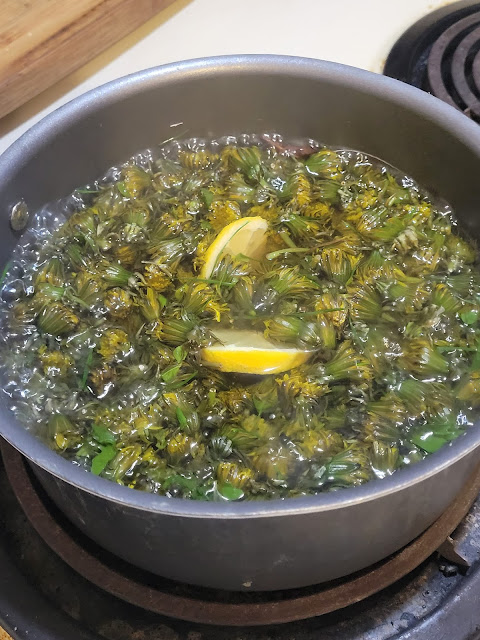Unleashing Nature's Culinary Treasures: Exploring the Delights of Foraging and Cooking with Wild Grape Leaves
Welcome to the world of foraging! It's an exciting journey filled with discoveries and culinary delights.
In this article, we'll explore the wonders of wild grape leaves—an abundant and nutritious resource that often goes unnoticed. Inspired by a neighbor's Turkish tradition, we'll dive into the realm of wild grape leaves and uncover their edible nature and the wealth of nutrients they offer. Whether you're a seasoned forager or a curious beginner, join us as we unveil the versatility of grape leaves and share a delicious recipe that will ignite your culinary creativity. Get ready to expand your foraging horizons and embark on a flavorful adventure!
Recipe: Stuffed Grape Leaves (Dolmades)
Ingredients:
- - Fresh wild grape leaves (a generous handful)
- - 1 cup uncooked rice (short-grain or medium-grain)
- - 1 small onion, finely chopped
- - 2-3 tablespoons olive oil
- - 2 tablespoons fresh lemon juice
- - 1 teaspoon dried dill (or 1 tablespoon fresh dill, chopped)
- - 1 teaspoon dried mint (or 1 tablespoon fresh mint, chopped)
- - Salt and pepper to taste
- - Optional: A handful of pine nuts or raisins for added texture and flavor
Instructions:
1. Harvesting Grape Leaves:
- Explore your local area for wild grapevines. Look for heart-shaped leaves with a slightly fuzzy texture.
- Carefully select fresh, vibrant grape leaves, avoiding any damaged or discolored ones.
- Harvest the leaves, ensuring minimal impact on the plant and its surrounding environment.
2. Preparing the Grape Leaves:
- Rinse the grape leaves under cold water to remove any dirt or debris.
- Blanch the leaves by briefly dipping them in boiling water for about 30 seconds. This step helps soften the leaves and remove any bitterness.
- Transfer the blanched leaves to a bowl of ice water to cool. Drain and pat them dry.
3. Preparing the Filling:
- In a skillet, heat olive oil over medium heat.
- Add the chopped onion and sauté until translucent and fragrant.
- Add the uncooked rice to the skillet and stir to coat it with the oil and onions.
- Pour in enough water to cover the rice by about 1 inch. Bring to a boil, then reduce the heat to low and let it simmer until the rice is cooked and the water is absorbed.
- Remove the skillet from heat and let the rice mixture cool slightly.
- Once cooled, add lemon juice, dried or fresh dill, dried or fresh mint, salt, pepper, and any optional ingredients like pine nuts or raisins. Mix well.
4. Assembling the Dolmades:
- Lay a grape leaf flat on a clean surface, vein side up.
- Place a spoonful of the rice filling near the stem end of the leaf.
- Fold the sides of the leaf over the filling, then roll it tightly from the stem end to the tip, creating a compact cigar-shaped bundle.
- Repeat the process with the remaining grape leaves and filling.
5. Cooking the Dolmades:
- Line the bottom of a pot with any torn or unused grape leaves to prevent the dolmades from sticking.
- Arrange the dolmades neatly in the pot, seam side down, in a single layer.
- Add enough water or vegetable broth to cover the dolmades.
- Cover the pot and bring it to a gentle boil. Reduce the heat to low and let it simmer for about 30-40 minutes, or until the rice is fully cooked and the grape leaves are tender.
6. Serving and Enjoying:
- Once cooked, carefully remove the dolmades from the pot and arrange them on a serving plate.
- Serve the dolmades warm or at room temperature as an appetizer or a main course.
- They pair wonderfully with a dollop of Greek yogurt or a squeeze of fresh lemon juice.
Congratulations on taking your first steps into the world of foraging!
By discovering the culinary potential of wild grape leaves, you've unlocked a treasure trove of flavors and nutrients. From their resemblance to cabbage to their rich nutritional profile, grape leaves offer endless possibilities in the kitchen. As you continue to explore the realm of foraging, remember to respect nature and its delicate balance. Share your newfound knowledge and delectable recipes with others, and let the flavors of wild grape leaves add a touch of excitement and creativity to your culinary repertoire. Embrace the joy of foraging, and savor the rewards of connecting with nature's bountiful offerings.























Comments